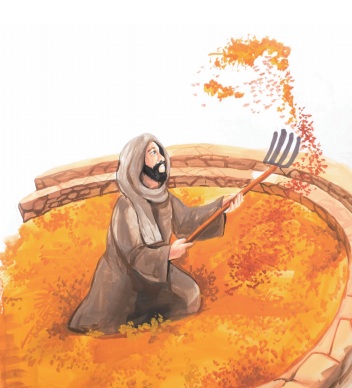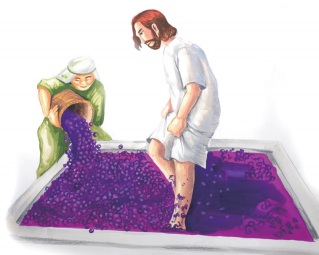|
Knowing the Farming Methods of the New and Old Testaments Will Bring More Insight into the Bible
|
|
|
글쓴이 :
관리자
|
|
Palestine-the center stage of the Bible?is about 8,000 km away from us who are reading the Bible. In terms of time, there is an interval of more than 2,000 years. Hence, we can say that by reading the Bible, we are crossing the bridge of time and space to meet the Word.
That is why it is not easy to read the Bible. There are many difficult misunderstandings if we perceive the Old and New Testaments based on today’s lifestyle and knowledge. Therefore, examining the lifestyle of the Old and New Testamental periods facilitates a correct under-standing of the Words in the Bible.
Israel’s Climate
The climate in Israel is divided into the dry season and rainy season. The six months of dry season from Nisan (first month of the Jewish/Hebrew calendar, March and April of the solar calendar) to Elul (sixth month of the Jewish/Hebrew calendar, August or September of the solar calendar), there is absolutely no rain. The extremely hot east wind dries out and hardens the land like stone. However, with the beginning of the rainy season in Tishri (seventh month of the Jewish/Hebrew calendar, October or November of the solar calendar) when the early rain falls, the dry land is made soft to make sowing possible. Cultivation begins when the early rain stops, and the late rain in the month of Nisan serves to bring the last fruition (Deuteronomy 11:14, Amos 4:7).

Israel’s Agriculture
Wheat and barley, the threshing floor
Digging furrows is not easy in Israel since the field is mixed with many stones; on the plowed land, Israel’s farmers sow seeds by throwing seeds or dropping seeds from the seed pouch hanging from the livestock. In this process, some seeds are blown away by the wind, falling near the roadside or among the thorns. Farmers plow the field and bury the seeds in the soil to prevent birds from eating the seeds. Jesus’ parable of the sower (Matthew 13, Mark 4, Luke 8) uses this background of the Israel farming method.
In particular, when farming wheat, tares grow among the wheat. Tares is a weed we call ‘ryegrass’ in today’s terms, and it is difficult to distinguish them from wheat when growing; but they can be clearly identified when the ears begin to show. When harvest time comes, the tall wheat is harvested first and the short tares are left until all wheat are harvested, after which they will be cut all at once and burned with fire.
When the late rain of Nisan passes, the barley is harvested and the first crop is offered during the Feast of the First Fruits while the wheat is harvested in Sivan (third month) and offered during the Feast of Ingathering (Feast of Weeks). Since tares are present among the barley and wheat for harvest at this time, they are taken to the threshing floor to reap the grain. Since tares are light and wind easily carries them away, the threshing floor is usually located at the highest point in the village made with a round space of approximately 15m. The harvested crops are laid out on the threshing floor to win-now, and when the crop is lifted, the grain will have fallen to the bottom whereas the tares will be carried away by the wind. For this reason, the threshing floor signifies abundance and joy of completing the harvest as well as the image of judgment. Because the threshing process lasts a few days, the field owner takes the workers up, sets up a tent, and proceeds with the threshing. This is the same background as when Ruth sneaked onto the threshing floor of Boaz. The most representative threshing floor in the Bible is the threshing floor of Araunah (Ornan) the Jebusite on which the temple was built. This site?which was origi-nally Mount Moriah where Abraham sacrificed Isaac?was the threshing floor of Araunah during David’s time, and it later became the site for Solomon’s temple.
Grape farming and pressing follow from the month of Tammuz (fourth month, June or July of the solar calendar) until Elul (sixth month, August or September of the solar cal-endar). The remaining crops in Israel?such as grapes, olives, dates, and pomegranates?ripen during this period. These fruits are harvested at the end of summer in the month of Tishri, and they are gathered into the storehouses to celebrate the Feast of Ingathering. Among these, grapes are considered the most valuable; they are mainly consumed as wine and raisins and are known as a symbol of abundance (Genesis 49:11, 1 Kings 4:25, 2 Kings 19:29, Proverbs 3:10, etc.). Wine in particular was essential in various rituals (Numbers 15:1-10), and the Talmud stipulates to drink four glasses of wine for the Passover.
Today, the Y-shaped wire stand is driven onto the grapevine to make the vines grow with-out limit, enabling large-quantity harvesting. Back in those days, however, they did not have this knowledge. Therefore, the grapevine grew from the ground and extended to wherever it pleased, like a snake crawling on the ground. During the rainy season, the stems that touched the ground would rot due to moisture, while during the dry season, the grapevine would take its own roots into the ground where could not fully absorb the nutrients. The farmers would place a stone to hold up the fruitful branches so that they do not touch the ground and cut off the rotten branches that did not bear fruit. Along with these backgrounds of grape cultivation in Israel, the parable of the vine in John chapter 15 reminds us to become fruitful branches by abiding in Jesus who is the true vine.

At the end of the grape harvest, the winepress and wine is made in the lowest region of the village where the wind does not blow. In order to bring out the sweetness, the grapes that were laid out in the sun for 2-3 days are put into the winepress and trodden barefooted to squeeze out the juice (Isaiah 5:2, Judges 9:27). Like the work folk songs of our country, the Israelites also sang songs while they made wine ( Jeremiah 25:30), these are the songs from Psalms 8, 57-59, 81 and 84, “set to Altashheth,” or “on the Gittith.” Therefore, threshing floor for the grape and jujube trees were set at the highest places, whereas the winepresses were set at the lowest regions. Abundant harvests in these two places signified the blessing of Israel’s greatest prosperity (Deuteronomy 15:14).
Various places in the Bible record Israel’s agricultural life in detail as references for parables.
They do not simply reflect the social aspects of the Biblical times. Such life of humanity?that had to plow the ground in order to eat of it ever since the fall?portrays God’s work in plowing the field of man’s heart to yield fruits of salvation. Correct knowledge of Biblical cultural custom enriches our understanding of the history of God’s salvation.
Written by the reporters of True Peace magazine
|
|

